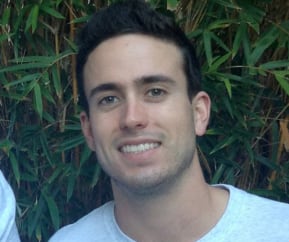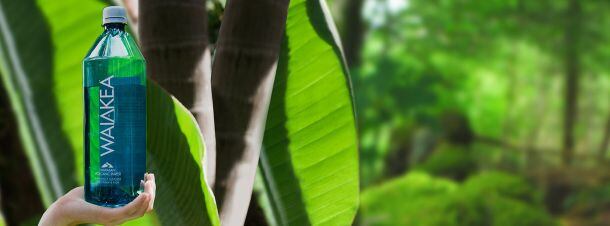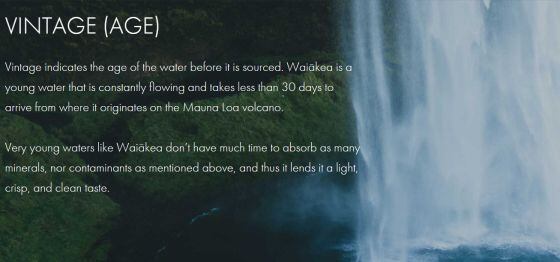The bottles will feature a patented additive from TimePlast, which weakens the chemical bonds in PET to accelerate the degradation process (the plastic eventually degrades into a carbon-based wax) but ensures it retains all of its functional properties, Waiākea founder and CEO Ryan Emmons told FoodNavigator-USA.
“We have rPET suppliers in the US that are starting to integrate the technology [one pound of the additive can alter one thousand pounds of plastic]. Hopefully we begin to see mass adoption over time, but we will be the first CPG food and beverage product to use the additive with our bottles and packaging.
“What’s also great is that at any stage the material can still go back into the recycling stream.”
Bottled water logistics
The move is one of several initiatives from Waiākea - which has been using 100% rPET bottles from its inception in 2012 – to reduce its environmental footprint, which on the face of it might seem pretty hefty given that it is shipping its naturally alkaline water across the Pacific (most of its customers are on the US mainland).
By drawing from one of the most sustainable fresh water resources in the world, using only 100% rPET bottles, utilizing low emission shipping, and participating in regional reforestation initiatives, however, Waiākea is certified CarbonNeutral, said Emmons, who recently opened a $1m bottling facility in Hilo on the east side of the Big Island, having previously shipped water over to California in bulk for bottling on the mainland.
“I know it doesn’t make much sense,” said Emmons, who said the plant has the capacity to support $50m in sales as is, “but it is cheaper to ship finished goods than raw water based off what the carriers prefer.”

Waiākea buys its 100% rPET preforms (which look like little test tubes) from the mainland and then turns them into its distinctive square bottles at its Hilo plant using a blow molder.
Ultimately, Emmons hopes to import rPET resin and create his own preforms in-house via injection molding, “or to just leverage the recycling stream in Hawaii to create our own resin and have a fully vertically integrated supply chain,” he added.
Rapid growth
Waiākea, which has been doubling in size each year for the past couple of years, is on course to increase revenues by around 85% this year as it continues to expand its distribution footprint and more consumers sign up for its subscription service, said Emmons, who believes the Waiākea brand could later move into other beverage categories, and develop into a fully-fledged lifestyle brand.
“We will sell between 300,000 and 350,000 cases this year. We’re in about 10,000 stores, up from about 5,000 last year, and expect to add another 7-10,000 stores next year, so we’re pretty thrilled. And a lot of the growth is coming from our c-store business, our most profitable business, other than our online operation.”
While Nielsen data collated by Wells Fargo shows US retail sales of bottled water fell 3% in the year to August 12, 2017, premium and super premium brands such as Waiākea, VOS and Fiji are still growing, he said.
“Our biggest growth has been in convenience but we’ve also layered in more foodservice and hospitality locations this year. We’ve maintained amazing partnerships in natural and specialty retail and we’re slowly starting to open up in conventional accounts such as Safeway and Ahold.”

E-commerce
Although shipping bottled water to people’s homes might not seem like a very economic option, meanwhile, the ecommerce operation is the most profitable part of Waiākea’s business, and it’s growing fast, said Emmons.
“Next year we should do over a million dollars solely on our own online platform [ the company's website]. We’ve done deals with Fedex and UPS that ultimately enable us to get anywhere in the country from $10-15 and for a 32lb case of water that’s not bad.
"We’re obviously subsidizing most of that shipping, but when you think you’re excluding 40-50% margins from retailers and another 15-25% from distributors, you’re still left with a lot of margin.”
He added: “About 60% of customers buying water through our website now use our subscription service, and we’ve seen that grow significantly as a percentage of our revenue over the past three years, so that e-commerce sales [through all online platforms including Amazon] are now a tenth of the business.”
Waiākea’s online success reflects an aggressive focus on digital marketing and advertising, he added: “What I like about it is that we can track the ROI; we know the lifetime value of our average customer is about $360 in a year, which is very good, so we’re able to calculate our desired spend. That leaves a lot of room for us to try and reach out to customers and give them meaningful health and lifestyle tips, and engaging stories, and keep them coming back.
“We also have our blog and our email newsletter, ads on facebook and pinterest and remarketing, so anyone that arrives on our website is targeted with native ads and traditional ads as they browse [other sites on] the web.”

Loyalty program
Emmons has also been testing an online loyalty scheme which rewards fans who refer a friend, share the website on facebook, write reviews, or follow Waiākea on Instagram, with points they can redeem for Waiākea products.
“The key is keeping it simple,” he said. “You need to have a significant pay off fairly quickly to engage people, but it’s already helping us spread our message.”
Who buys Waiākea?
The data gleaned from the company’s online channels has also revealed that Waiākea’s customer base is potentially broader than he originally envisaged, said Emmons.
“When we launched, we targeted more affluent metro areas, but we found out that our preconceptions were wrong and we had a wider array of customers from different backgrounds and locations, which is pretty exciting.”

Where does Waiākea’s water come from?
Waikea's water - which is filtered through thousands of feet of porous volcanic rock on Hawaii’s Big Island (infusing it with sodium, calcium, potassium, silica and magnesium) and drawn from the Kea'au aquifer - is unusual in that it is naturally alkaline (around pH 7.2-8.2), a point of difference for many bottled water consumers on the US mainland.
The source of Waiākea’s water has generated some negative press for the business, which was until recently tapping the naturally alkaline municipal water supply, but is now drawing its water from a private source (obtained through a longstanding relationship Emmons has with a Hawaiian family): a deep well on an adjacent aquifer with a similar total dissolved solids and mineral content and pH.
According to FDA rules, the product is now classified as [deep] well water, which means Waiākea no longer has to label its wares as coming from a community/municipal water source, although in reality all of these distinctions are somewhat moot, given that “most of the water on the east side of the island is pretty amazing as it’s filtered through the same volcanic rock,” Emmons explains.
He added: “Even though some competitors are similarly sourced from the same depth and well type and pressure, yet say they are ‘artesian,’ we have decided to stick with this FDA classification [well water] until it is proven their sources do not meet that definition. Many blind water testings favor well water over spring and artesian and there usually is more protection from potential ground water infiltration.”
So what’s the difference between the old and the new water source?
“The community water source used last year had an amazing total dissolved solids and pH and was sourced from a very sustainable aquifer, the Pahoa aquifer,” explained Emmons. “It really can't be compared to anything on the mainland. We used carbon filters to remove chlorine so you were left with a delicious water with a mineral profile and taste comparable to some of the best premium water brands in the world. Our new Hawaiian family source removes this [de-chlorination] step and is sourced at a slightly higher elevation and different aquifer.
“It’s still part of the same Mauna Loa aquifer system, yet is very similar in taste and terroir. The new source is untouched and filtered only through UV light.”
